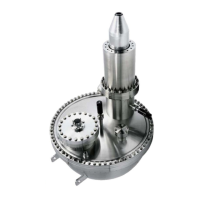Analyzer Checks
a broad illuminating X-ray source, additional “MCD Calibration” for the point source
may be required.
8.2 Energy Scale Tests with XPS
8.2.1 Check Kinetic Energy Scale
Transfer a gold/copper sample into the system. Clean carefully by ion sputtering. With
this sample the main peaks are separated far enough for calibration purposes. The Au
4f7/2 and Cu 2p3/2 peaks energy difference is 848.66 ± 0.03 eV
2
.
Adjustments:
Excitation Mg Kα
X-ray power 100 W
Slit entrance: largest slit / exit: open
Mode Medium Area
Binding energy range 82 - 86 eV for the Au 4f7/2 peak
930 - 937 eV for the Cu 2p3/2 peak
Dwell Time 100 msec
Scan 1
Energy step 25 - 30 meV
Pass energy ~8 eV
8.2.2 Check Peak Position
Check for proper peak positions corresponding to table 14 on page 67. If the peaks off-
set consistently, check if the proper peak position can be achieved by correcting the
Work Function, sections 7.4 - “Work Function Calibration with UPS” on page 61, 7.5 -
“Work Function Calibration with XPS” on page 62 or 7.7 - “Gain Calibration with XPS”
on page 64. If this is not the reason, a complete calibration (as described at the begin-
ning of this chapter) is required or there is a failure in the analyzer or supply (chapter 6,
"Troubleshooting" on page 51).
Note: Strong displacement usually caused by poor contact inside the analyzer (see
“Connection check for the analyzer electrodes” on page 70) or control unit failure (see
“Control Unit Check” on page 61) .
Peak
Mg Kα
Binding Energy, eV
Al Kα
Binding Energy, eV
Au 4f7/2 84.00 ± 0.01 83.98 ± 0.02
Ag 3d5/2 368.27 ± 0.01 368.26 ± 0.02
Cu 2p3/2 932.66 ± 0.02 932.67 ± 0.02
2 XPS: Binding Energy Calibration of Electron Spectrometers 5 - Re-evaluation of the Reference Energies.
M.P.Seah, I.S.Gilman and G. Beamson, Surfaceand Interface Analysis 26, 642-649 (1998)
66 PHOIBOS

